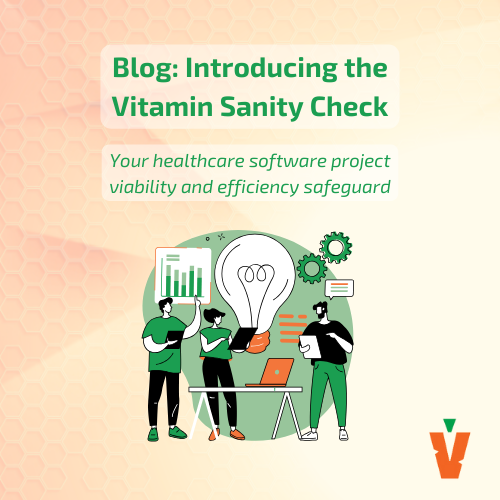Healthcare executives, take note: client satisfaction and engagement are goals worth prioritizing (by up to 65% likelihood of sales). And today, we're discussing ways to keep these numbers steady and high.
Getting new clients is more expensive and resource-intensive than working with existing ones. While it pays to pay the high CAC to grow net new sales, your company will fare better if it backs these expenses with the revenue they can extract from (and value they can deliver to) clients already in your network. Today, we discuss ways to maximize the utility of resources at your disposal to power growth and maintain stability in your company.
We at Vitamin are veterans in regulated industries, with ample experience in maintaining relationships with healthcare SaaS vendors and operators. Discover our principles for maintaining connections with major healthcare clients, including digital pharmacies, top US hospitals, and government service providers.
Step 1: Assessing the Situation
Let’s begin by discussing three checks to assess the client relationship. They help you turn the gut feeling that something is off into actionable ideas to improve client engagement.
Are You Doing Regular NPS Checks?
As most Client Success Managers know, the average NPS in the SaaS industry is 36. A lower figure is a red flag.
The calculation can fall to the wayside due to more pressing tasks, and then what? In addition to this number quantifying success and pinpointing at-risk clients, it’s a great tool to spot market growth opportunities and get on the competitive wagon.
Let’s be honest — are you consistently implementing the NPS process? And if so, does your team turn metrics into actionable items or just let it sleep on the pile of annual reports?
Client Success Managers can ensure that NPS is more than irrelevant busywork, and that it actually helps your organization grow. The best way to do that is by seeing the number as an objective tool that helps you catch obstacles in the client relationship before they cause trouble. In some cases, it can even point to market openings you can capture before your competitors.
What should you do?
Establish a regular schedule for conducting NPS surveys to access current and historical data. From our experience, quarterly checks are the sweet spot for bigger healthcare enterprise entities that generate at least $50 million of revenue a year. Display the results within your team’s workspace as a constant reminder that client satisfaction comes first. Create an actionable loop so that the delivery and engineering team can actually use the information to delight your clients.
How Can You Surpass Competition?
As healthcare is slow to digitize, developing in step with the latest technologies is a good way to maintain a competitive edge. The trick’s in getting conservative stakeholders on-board with your riskier projects.
Let’s face it — not all projects will be successful. But those that are could bring a competitive advantage to your company. That’s why you should analyze ideas on a smaller scale first, figuring out what works before throwing the whole weight of your reputation behind it. If the internal team lacks the time or tech knowledge to do it, hiring external partners could be the way to go. That’s where we at Vitamin may enter the picture.
In healthcare Saas, the most useful projects are those that improve customer experience, reduce costs, or speed up operations. For instance, predictive medicine that uses machine learning and artificial intelligence is the next big thing for all three reasons. Also, anything that improves security and compliance is a bonus.
How Do You Convince Your Board to Allocate Resources to Testing New Ideas?
We’re noticing a trend of healthcare vendors and providers becoming more sophisticated users with high expectations. Quality software translates into client retention and growth. Slow performance, unresponsive design, inadequate compliance, and poor SaaS security will be less tolerated in 2024 and beyond.
How can a Client Success Manager approach the board with a new idea or upgrade suggestion that hasn’t been tested before in healthcare?
The first step is to collect data and quantify the cost of poor software experience. Estimate potential revenue loss, support costs, and new customer acquisition expenses.
Second, educate the board on the financial and technical impact of your suggested solution. You could devise a plan beforehand or propose several viable options, letting them decide on the course they want to take. Have a ballpark of the cost and demonstrate the financial gains that may come from investing in quality.
In a nutshell, you want to facilitate the board’s decision-making process for an easy approval. Never ask them to take massive risks head-on, and don’t demand funds to be relocated from existing, money-making products.
Step 2: Re-Engaging Customers
Once you have the reasons for low engagement, it’s time to move on to solutions. Use these ways to re-engage and re-delight your old client base:
- Personalize the communication. Modern buyers are skeptical about marketing and sales, only responding to relevant messages. Join forces with your marketing team on customer relationship management to tailor your communications. Analyze and utilize the data to craft your check-ins to each client.
- Suggest new features or enhancements. Analyze the prior engagement with your client and craft new offerings that build onto them. Share success stories of companies benefitting from similar features. For example, Pfizer uses AWS to boost their computing capacities — why wouldn’t other biopharma companies follow suit?
- Talk about their needs. Re-engagement requires a pitch, and it shouldn’t be about your company or the latest product. Instead, have it focused on their issues. Position yourself as a consultant instead of a pushy vendor seeking to make a new sale. To illustrate, our sales team spends hours researching prospective clients before reaching out. For the most precious accounts, our CEO personally crafts offers that are about collaboration and supporting their efforts — and his approach consistently yields success.
- Incentivize engagement with perks. It may sound like a waste of funds, but it works, as loyalty programs are an effective retention tool. Use exclusive access, discounts, membership tiers, and personalized recognition as rewards for ongoing commitment. If you have a subscription-based platform, gamification is also worth exploring. Insurance companies like Aviva and United Healthcare use this strategy for their complex, highly regulated field, offering a case study for healthcare SaaS implementation.
Many companies lack a feedback loop between their Sales, Marketing, and CSS teams, which hinders their effort to improve client engagement.
Take this tip from marketing and apply it across the board — personalizing the re-engagement journey makes it more successful. A CRM tool like HubSpot makes all the difference by offering insights and targeting relevant audience segments. Companies like VitraMed already use it to align teams and reach their goals faster.
For an in-depth look at how HubSpot CRM helps healthcare CSS, explore their healthcare case studies.
Even HIPAA-compliant companies use HubSpot to manage client relationships. It’s a sophisticated tool with fantastic insights, reducing the workload of your CSS team. Although not regulated, it integrates with data privacy vaults to keep your client data private.
I’ve noticed a big trend of health tech and insurance companies switching to HubSpot. The platform makes it much easier to manage marketing, sales, and client relationships in healthcare.
— Ema Odorović, Director of Marketing at Vitamin Software
Step 3: Strengthening the Relationship
Are you selling your product or helping clients resolve an issue? The highest-performing companies know their clients’ needs and pain points inside-and-out and never come off as salesy, which is critical in developing relationships in healthcare environments.
Strong client relationships require trust and dedication from both sides. Find ways to reliably make healthcare SaaS clients’ lives easier, and they won’t have the need to go anywhere else.
How do you do that? By honestly caring about them. Just analyzing their data will get you some information, but not enough to consistently improve client engagement. In the era of overstimulation, we all respond quite well to authentic human care. The best part — you can use technology to make this easier.
Getting Higher-Quality Data Faster With AI and ML
As modern tech consumers are sophisticated and have high expectations, companies must zero in on meeting their clients’ needs. Instead of comparing yourself with the competition, be the answer to the questions they have now and hurdles they might face in the future.
Client-centric data lets you tailor messaging and identify times when you can upsell, cross-sell, or gain referrals while delivering value. And that requires technology (or many hours of manual labor).
The combination of AI and ML can organize large amounts of data into a dashboard. It lets you analyze the client’s journey from lead generation to post-purchase, seeing what worked. Then, an expert CSS leverages it for proactive suggestions, discussions, or offers.
If you’re not already using chatbots to filter out queries, begin right now. That way, you’re always available for common queries, as clients expect no less. Customer success bots like the one by Totango go further, tracking people’s behaviors and supporting your tasks. They reduce legwork and let the CSS focus on what matters — complex human interactions.
Another way to leverage AI is to identify and re-engage at-risk clients. This gives you ample time for course-correction. Whether the next step is a virtual tour of your development process or a personalized thank-you note, catching trouble early is key to avoiding it.
Re-engage, Retain, Grow
Tech-empowered companies are about innovation and growth, and the Client Success Manager leads much of it. Even though it sounds odd, a reduction in client engagement rates can actually become your superpower — it illuminates the fields where you can gain the biggest benefits from improvement.
Introducing high quality upgrades should improve client engagement, but untested features without a proper process create friction and harm the end user experience. Get a proof of efficiency before taking it large-scale. Need help check the timeline or viability of your idea? Book a call with our consulting team and save valuable time and energy for client interactions.
Vitamin Software is your trusted technical partner for regulated industries. Leverage our expertise to boost your business and engage your clients.




.png)